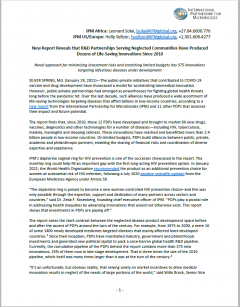New Report Finds that R&D Partnerships Have Produced Dozens of Lifesaving Health Innovations Since 2010
Novel product development model that offers cost-effective way to target infectious and neglected diseases has 375 innovations under development
SILVER SPRING, Md. (January 28, 2021)—The public-private initiatives that contributed to COVID-19 vaccine and drug development have showcased a model for accelerating biomedical innovation. However, public-private partnerships had emerged as powerhouses for fighting global health threats long before the pandemic hit. Over the last decade, such alliances have produced a wide assortment of lifesaving health technologies targeting diseases that afflict billions in low-income countries, according to a new report from International Partnership for Microbicides (IPM) and 11 other PDPs, which assesses their impact and future potential.
Since 2010, these 12 PDPs have developed and brought to market 66 new drugs, vaccines, diagnostics and other technologies for a number of diseases—including HIV, tuberculosis, malaria, meningitis and sleeping sickness—where there is a lack of traditional market incentive. These innovations have reached and benefitted more than 2.4 billion people in low-income countries. PDPs build alliances between public, private, academic and philanthropic partners, enabling the sharing of financial risks and coordination of diverse expertise and experience.
IPM’s dapivirine vaginal ring for HIV prevention is one of the successes showcased in the report. The monthly ring could help fill an important gap with the first long-acting HIV prevention option. In January 2021, the World Health Organization recommended the product as an additional prevention choice for women at substantial risk of HIV infection, following a July 2020 positive scientific opinion from the European Medicines Agency under Article 58.
“The dapivirine ring is poised to become a new woman-controlled HIV prevention choice–and this was only possible through the expertise, support and dedication of many partners across sectors and countries,” said Dr. Zeda F. Rosenberg, founding chief executive officer of IPM. “PDPs play a pivotal role in addressing health inequities by advancing innovations that would not otherwise exist. This report shows that investments in PDPs are paying off.”
Since their inception, PDPs have marshalled industry, government and philanthropic investments and generated new political capital to pack a once-barren global health R&D pipeline. Currently, the cumulative pipeline of the PDPs behind the report contains more than 375 new innovations, 25% of them now in late-stage development. That is three times the size of the 2010 pipeline, which itself was many times larger than it was at the turn of the century.
The report also documents how PDPs have helped build global capacity to conduct cutting-edge medical research, including working with 550 clinical trial sites in some 80 mostly developing countries. It notes that this global infrastructure has been tapped to speed the development of COVID-19 vaccines and treatments, and that PDPs have contributed in many other ways to fighting the pandemic alongside maintaining progress against existing health threats and responding to emerging ones.
The report finds that a key factor in the success of the PDPs is that they are developing products that are both affordable and easy to administer—like heat-stable innovations versus those with significant refrigeration needs. It also reveals that PDPs are cost-effective. For example, DNDi estimated their cost to develop and bring fexinidazole to market at between US $70-225 million, compared to the $1.3 billion estimated by the Tufts Center for Study of Drug Development as the average cost for for-profit pharmaceutical companies to develop a novel chemical entity.
The future success of PDPs will require a strong focus on late-stage research and efforts to ensure access to recently launched technologies, according to the report, which concludes that “with more products approaching and reaching the market than ever before, the need to invest in research and access is increasingly critical and urgent.”
Read the full release
Read the report: Executive summary or full report
For additional information and to read case studies from each of the 12 PDPs, please visit www.KeepingThePromiseReport.org.
About IPM: IPM is a nonprofit organization dedicated to developing new HIV prevention tools like the dapivirine ring and other sexual and reproductive health technologies for women, and making them available in developing countries. IPM has offices in the United States, South Africa and Belgium. Please visit www.IPMglobal.org.

